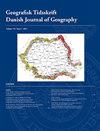Explaining the variation in historical trends for agriculture and population density using soil, climate, and topography data. A case study from Denmark
IF 1.1
4区 社会学
Q4 ENVIRONMENTAL STUDIES
Geografisk Tidsskrift-Danish Journal of Geography
Pub Date : 2021-07-03
DOI:10.1080/00167223.2021.1949366
引用次数: 0
Abstract
ABSTRACT Agricultural land use and population density have been increasing around the world. Determining if physical geography is a driving factor of historical change on a larger scale has received little research interest in the past outside local-scale case studies. The aim of this study was to model historical agricultural development and population density throughout Denmark using geographically weighted regression with environmental variables and data for parishes from 1860 to 1890. We analysed rye production, sheep count, and population density on the national scale. The incorporated variables were selected to represent aspects of soil, climate, and topography. Models for rye and sheep had high explanatory power (global R2: between 0.60 and 0.68) for both time periods whereas the model for population density had low explanatory power (global R2: 0.09 in 1860 and 0.25 in 1890). The results indicate that historical development in agricultural geography can be explained using physical geography. However, population density is more complex due to influences of industrialization, culture and scalar structure. This questions the classical understanding that soil quality is a strong determinant of population density on its own in Denmark. We instead argue that soil quality has a dynamic multidirectional interplay with human and agricultural activity.利用土壤、气候和地形数据解释农业和人口密度的历史趋势变化。来自丹麦的案例研究
世界各地的农业用地和人口密度都在不断增加。在过去,除了局部尺度的案例研究之外,确定自然地理是否是更大尺度上历史变化的驱动因素的研究兴趣很少。本研究的目的是利用地理加权回归,结合环境变量和1860年至1890年的教区数据,对整个丹麦的历史农业发展和人口密度进行建模。我们在全国范围内分析了黑麦产量、绵羊数和人口密度。合并变量被选择来代表土壤、气候和地形的各个方面。黑麦和绵羊模型在两个时间段具有较高的解释能力(总体R2为0.60 ~ 0.68),而种群密度模型的解释能力较低(总体R2为1860年的0.09和1890年的0.25)。结果表明,农业地理学的历史发展可以用自然地理学来解释。然而,由于工业化、文化和标量结构的影响,人口密度更为复杂。这对传统的理解提出了质疑,即土壤质量是丹麦人口密度的一个重要决定因素。相反,我们认为土壤质量与人类和农业活动具有动态的多向相互作用。
本文章由计算机程序翻译,如有差异,请以英文原文为准。
求助全文
约1分钟内获得全文
求助全文
来源期刊
CiteScore
5.20
自引率
0.00%
发文量
5
期刊介绍:
DJG is an interdisciplinary, international journal that publishes peer reviewed research articles on all aspects of geography. Coverage includes such topics as human geography, physical geography, human-environment interactions, Earth Observation, and Geographical Information Science. DJG also welcomes articles which address geographical perspectives of e.g. environmental studies, development studies, planning, landscape ecology and sustainability science. In addition to full-length papers, DJG publishes research notes. The journal has two annual issues. Authors from all parts of the world working within geography or related fields are invited to publish their research in the journal.

 求助内容:
求助内容: 应助结果提醒方式:
应助结果提醒方式:


